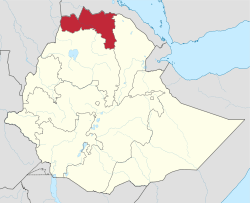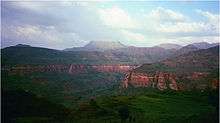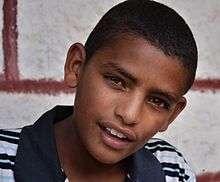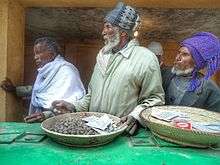Tigray Region
| Tigray Region ክልል ትግራይ | ||
|---|---|---|
| kilil | ||
| ||
 Map of Ethiopia showing Tigray Region | ||
| Country | Ethiopia | |
| Capital | Mekelle | |
| Area | ||
| • Total | 41,409.95 km2 (15,988.47 sq mi) | |
| [1] | ||
| Population (2015) | ||
| • Total | 5,416,988 | |
| • Density | 130/km2 (340/sq mi) | |
| ISO 3166 code | ET-TI | |
Tigray Region (ክልል ትግራይ kilil Tigrāy) is the northernmost of the nine regions (kililat) of Ethiopia. Tigray is the homeland of the Tigray, Irob and Kunama people. Tigray is also known as Region 1 according to the federal constitution. Its capital is Mek'ele (also spelt Mekelle).
Tigray is bordered by Eritrea to the north, Sudan to the west, the Afar Region to the east, and the Amhara Region to the south and southwest.[2] Besides Mek'ele, major cities include Hawzen, Abiy Addi, Alamata, Mekoni, Adigrat, Adwa, Axum, Humera, Korem, Maychew, Qwiha, Shire (Inda Selassie), Wukro and Zalambessa. There is also the historically significant town of Yeha.
History
- For the history of the Tigray area prior to 1991, see Tigray Province.

Following the conclusion of the Ethiopian Civil War, although the area which became the Tigray Region was thought by inhabitants in the rest of Ethiopia to be the beneficiaries of enormous funds from an Ethiopian People's Revolutionary Democratic Front (EPRDF) government dominated by fellow Tigrayans, in reality the beneficiaries are mostly the party members of Tigray people liberation front /TPLF/. John Young, who visited the area several times in the early 1990s, attributes this delay in part to "Budgetary restraints, structural readjustments, and lack of awareness in Addis Ababa of conditions in the province", but notes "an equally significant obstacle was posed by an entrenched, and largely tigrian dominated central bureaucracy which used its power to block even authorised funds from reaching all regions." At the same time, a growing urban middle class of traders, businessmen and government officials emerged which was both suspicious and distant from the victorious EPRDF. The ruling party attempted to address these challenges in forums with its middle class critics, as well as the establishment of a number of charitable non-governmental organizations controlled by the EPRDF, which include Endowment Fund for the Rehabilitation of Tigray, Relief Society of Tigray, and Tigray Development Association.[3]
In 1998, war erupted between Eritrea and Ethiopia over a portion of territory that had been administered at part of Tigray, which included the town of Badme. Following a 2002 United Nations decision, much of this land was awarded to Eritrea, so far however, Ethiopia has refused to implement the final and binding ruling and as a result, relation with Eritrea is very tense.
Demographics


Based on the 2007 Census conducted by the Central Statistical Agency of Ethiopia (CSA), the Tigray Region has a population of 4,316,988, of whom 2,126,465 are men and 2,190,523 women; urban inhabitants number 844,040 or 19.55% of the population. With an estimated area of 41,409.95 square kilometers, this region has an estimated density of 100 people per square kilometer. For the entire region 992,635 households were counted, which results in an average for the Region of 4.4 persons to a household, with urban households having on average 3.4 and rural households 4.6 people.[4]
In the previous census, conducted in 1994, the Region's population was 3,136,267, of whom 1,542,165 were men and 1,594,102 women; urban inhabitants numbered 621,210 or 14% of the population.
According to the CSA, as of 2004, 53.99% of the total population had access to safe drinking water, of whom 42.68% were rural inhabitants and 97.28% were urban.[5] Values for other reported common indicators of the standard of living for Tigray as of 2005 include the following: 31.6% of the inhabitants fall into the lowest wealth quintile; adult literacy for men is 67.5% and for women 33.7%; and the Regional infant mortality rate is 67 infant deaths per 1,000 live births, which less than the nationwide average of 77; at least half of these deaths occurred in the infants’ first month of life.[6]
Ethnicity
At 96.55% of the local population, the region is predominantly inhabited by the Tigrinya speaking Tigray people. The Tigrinya language is classified as belonging to the Semitic branch of the Afro-Asiatic family of languages. Most other residents hail from other Afro-Asiatic speaking communities, including the Amhara, Irob, Afar, Agaw and Oromo. There are also a minority of Nilo-Saharan-speaking Kunama Nilotes.
| Ethnic group |
1994 Census | 2007 Census |
|---|---|---|
| Tigray | 94.98% | 96.55% |
| Amhara | 2.6% | 1.63% |
| Irob | 0.7% | 0.71% |
| Afar | - | 0.29% |
| Agaw | - | 0.19% |
| Oromo | - | 0.17% |
| Kunama | 0.05% | 0.07% |
Religion
| Religion | 1994 Census | 2007 Census[7] |
|---|---|---|
| Orthodox Christians | 95.5% | 95.6% |
| Muslim | 4.1% | 4.0% |
| Catholics | 0.4% | 0.4% |
| Protestant | - | 0.10% |
Languages
The working language is Tigrinya, although most urban people are also able to speak Amharic, which was taught in schools.[9]
Agriculture
The CSA estimated in 2005 that farmers in Tigray had a total of 2,713,750 cattle (representing 7.0% of Ethiopia's total cattle), 72,640 sheep (0.42%), 208,970 goats (1.61%), 1,200 horses (less than 0.1%), 9,190 mules (6.24%), 386,600 asses (15.43%), 32,650 camels (7.15%), 3,180,240 poultry of all species (10.3%), and 20,480 beehives (0.47%).[10]
Landmarks

A distinctive feature of Tigray are its rock-hewn churches. Similar in design to those of Lalibela in the Amhara Region, these churches are found in four or five clusters – Gheralta, Teka-Tesfay, Atsbi and Tembien – with Wukro sometimes included. Some of the churches are considered earlier than those of Lalibela, perhaps dating from the eighth century. Mostly monolithic, with designs partly inspired by classical architecture, they are often located at the top of cliffs or steep hills, for security. For example, Tigray's ancient Debre Damo monastery is accessible only by climbing a rope 25 meters up a sheer cliff.
Looting has become a major issue in the Tigray Region, as archaeological sites have become sources for construction materials and ancient artifacts used for everyday purposes by local populations.[11]
The area is famous for a single rock sculptured 23 meter long obelisk in Axum as well as for other fallen obelisks. The Axum treasure site of ancient Tigrayan history is a major landmark. Yeha is another important local landmark that is little-known outside the region.
Presidents of the Executive Committee
- Gebru Asrat (TPLF) 1991–2001
- Tsegay Berhe (TPLF) 2001–2010
- Abay Woldu (TPLF) 2010–present[12]
Administrative zones
Like other Regions in Ethiopia, Tigray is subdivided into administrative zones
- Central Tigray
- East Tigray
- North West Tigray
- South Tigray
- South East Tigray
- West Tigray
- Mekele (special zone)
See also
References
- ↑ 2011 National Statistics
- ↑ Eritrea and Ethiopia (Map). 1:5,000,000. Central Intelligence Agency. 2009. Map #803395.
- ↑ Young, "Development and Change in Post-Revolutionary Tigray", Journal of Modern African Studies, 35 (1997), pp. 81-99
- ↑ Census 2007 Tables: Tigray Region, Tables 2.1, 2.5, 3.1, 3.2, 3.4.
- ↑ "Households by sources of drinking water, safe water sources" CSA Selected Basic Welfare Indicators (accessed 21 January 2009)
- ↑ Macro International Inc. "2008. Ethiopia Atlas of Key Demographic and Health Indicators, 2005." (Calverton: Macro International, 2008), pp. 2, 3, 10 (accessed 28 January 2009)
- ↑ "Census 2007", first draft, Tables 1, 4, 5, 6.
- ↑ people of ethiopia
- ↑ "FDRE States: Basic Information - Tigray". Population. Archived from the original on 26 September 2007. Retrieved 22 March 2006.
- ↑ "CSA 2005 National Statistics", Tables D.4 - D.7.
- ↑ Jacke Phillips, Tekle Hagos et alia, "Combating the destruction of Ethiopia's archaeological heritage", Antiquity, 78 (December 2004)
- ↑ "Ethiopian Regional States".
External links
![]() Media related to Tigray Region at Wikimedia Commons
Media related to Tigray Region at Wikimedia Commons
- Tigrai Region Web Portal
- Tigrai Revenue Development Authority
- Tigrai State Information
- FDRE States: Basic Information - Tigray
- Map of Tigray Region at UN-OCHA
- Map of Tigray Region at DPPA of Ethiopia
- Endowment Fund for the Rehabilitation of Tigray website
- Ethiopian Treasures - Queen of Sheba, Aksumite Kingdom - Aksum
- Ethiopian Treasures - Emperor Yohannes IV Castle - Mekele
- Future Observatory - Dam Building in Tigray by David Mercer
- "Tigrayans want end to border row" by Elizabeth Blunt, BBC News, 20 December 2007
- Tigray: Then and Now - the son of Mohamed Amin covers sustainable agriculture in Tigray following the Horn of Africa drought in 2011.
Coordinates: 14°08′12″N 38°18′34″E / 14.1365757°N 38.3093262°E
